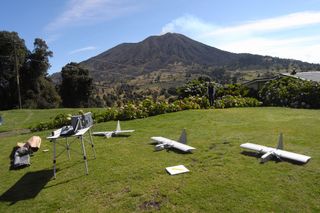Unmanned NASA Planes Fly Through Poisonous Volcanic Fumes

Planes designed for urban warfare are helping scientists track poisonous volcanic gas.
The Dragon Eye remote-controlled plane weighs in at just under 6 pounds (2.7 kilograms), with a 3.75-foot (1.14 meters) wingspan and two electric motors. Designed for the U.S. Marine Corps, the plane is light enough to carry and launch for reconnaissance.
NASA recently acquired three retired Dragon Eye planes and sent them to Costa Rica to monitor Turrialba Volcano. Ongoing sulfur dioxide gas emissions from the volcano create vog, or sulfur dioxide smog, which wreaks havoc on crops and harms people who are sensitive to atmospheric pollutants.
The project's goal is to improve satellite maps of the direction of volcanic plumes, and the concentration and distribution of volcanic gases.
"It is very difficult to gather data from within volcanic eruption columns and plumes because updraft wind speeds are very high and high ash concentrations can quickly destroy aircraft engines," David Pieri, the project’s principal investigator and a research scientist at NASA's Jet Propulsion Laboratory in Pasadena, Calif., said in a statement. "Such flight environments can be very dangerous to manned aircraft."
The Dragon Eye flights were coordinated with an overhead pass of NASA's Terra satellite, so onboard satellite data could be compared with information collected via the unmanned planes. The study will improve models of volcanic eruption plumes from Terra satellite data.
The unmanned aerial vehicles carried a 1-pound (0.5 kg) sensor payload above the volcano's summit, with flights ranging as high as 12,500 feet (3,810 m) above sea level, according to a NASA statement. Researchers launched 10 flights between March 11 and 14.
Get the Space.com Newsletter
Breaking space news, the latest updates on rocket launches, skywatching events and more!
NASA scientists plan to return to Turrialba next year with a larger plane, the SIERRA unmanned aircraft (a 100-pound payload, or 45 kg), to measure additional gases in volcanic fumes, NASA said.
Email Becky Oskin or follow her @beckyoskin. Follow us @OAPlanet, Facebook or Google+. Original article on LiveScience's OurAmazingPlanet.
Join our Space Forums to keep talking space on the latest missions, night sky and more! And if you have a news tip, correction or comment, let us know at: community@space.com.

Becky was a science reporter at The Pasadena Star-News. She has freelanced for New Scientist and the American Institute of Physics and interned at Discovery News. She earned a master's degree in geology from Caltech, a bachelor's degree from Washington State University, and a graduate certificate in science writing from the University of California, Santa Cruz. To find out what her latest project is, you can follow Becky on Twitter.

